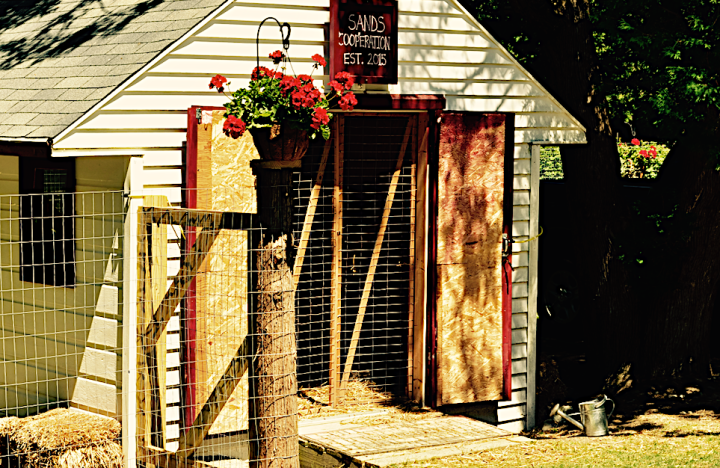In my series on raising chickens self sufficiently, I will be offering advice on how you can establish a symbiotic relationship with your flock–where you take good care of them and they take good care of you. I will teach how to minimize your costs and how to take full advantage of the resources chickens provide.
But in all of that, the reality is that a chicken coop is going to be a big, upfront cost for people, so we should probably address coops early on.

There are many options for coops. You can buy them, build them, covert a shed, but you really want to keep in mind five basic things when it comes to coops:
- You need to be able to provide shelter from the elements, whether you live in hotter or colder climates.
- Your coop needs to be sturdy enough to provide protection from predators. Now, there is no such thing, I think, as a 100 percent predator-proof coop, but you do want to do your very best.
- Coops need good ventilation, and we have found, over the years, that we need to adjust our ventilation depending upon the season and the number of chickens we have, so need vents you can open and close.
- As a rule of thumb, you want to aim for at least three square feet per chicken in your coop.
- You will need to make sure your coop has room for nests and roosts.
Buying a Coop
There are pre-made coops you can purchase online that range a great deal in price. There are coops for as little as $200 and as much as $900. There was even a $100,000 coop I saw once, but it had a crystal chandelier, and you probably don’t need that.
I have seen mixed reviews on the pre-made coops. Some people curse them; some people love them. Just be sure to do your diligent research and read the reviews before you buy any pre-made coop online or from a store.
You can also purchase smaller coops from local builders. Here in Maine, we have Facebook forums dedicated to all things chicken, and people who build coops will list them for sale. The price might be a little higher in some cases, but I have seen some really sturdy-looking coops for sale for $400 to $600.
Building a Coop
If you are handy or know someone who is, you can also simply build a coop. There are free plans online for building chicken coops, such as those listed at this site, at the Backyard Chicken Project.
You can also purchase coop plans for a very reasonable price on Etsy, and I like this idea because a lot of the excellent plans there include reviews, pictures from folks who have built the coops from the plans, and excellent information on the cost of materials.
This coop plan is one of my favorites because the coop seems really sturdy and covers all of the basic elements I think someone needs. The cost for building materials for this one is $700 to $800, but I am convinced it can be done more cheaply. One of the things I am seeing right now is a lot of people trying to help each other out. Get into your state and local farming, chicken, and homesteading Facebook groups. I am seeing people sharing materials and donating extra materials to others. Sometimes, the kindness in humanity is profound to me and gives me so much hope.
Converting a Shed
This is the option we took on our homestead because we wanted a big coop as cheaply as possible. If you convert a shed to a coop, you will need to add a small door for the chickens (at least this is preferable), nest boxes, roosts (which can be built from tree branches), and in an ideal world, windows for extra light. However, I know a lot of people who were not able to add windows and do okay. I think they would be a preference though.

Other Considerations
Coop Placement
You want to place your coop away from woods and easy access to predators. We have ours close to our house for that reason, but, in the summer, when the windows are open, the chickens are quite loud–even the hens–especially the hens. Ask me sometime about the egg song.
You also want to make sure you place your coop on good ground that is high enough not to be flooded.
Runs and Free Ranging
I will write about about the pros and cons of free ranging in another post, but, at the very least, you will need a run or some kind of fenced area for your chickens. If you plan to let them completely free range, there are risks to your birds and risks related to neighbors.
Food and Water Placement
Some coops are not large enough for food and water to be placed inside the coop. In those cases, you can place the food and water outside in the run. However, if you have a coop large enough, as with our coop/shed, you will have to decide whether or not you place the food inside. We place our food and water inside because, in the winter, our chickens stay in the coop, but if you have a run you can protect in the winter, you may not need to place food and water inside.
There are pros and cons to keeping the food inside. I like the easy access, but we did have rats in the coop one year and had to trap for several weeks to get them all.
I hope this is helpful enough to get you started. If you have any questions, post it in the comments section. I will do my best to answer questions!
Thx, it’s really decent info for beginners
LikeLiked by 1 person